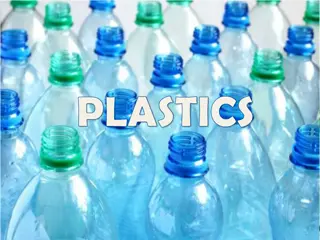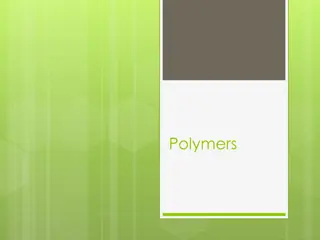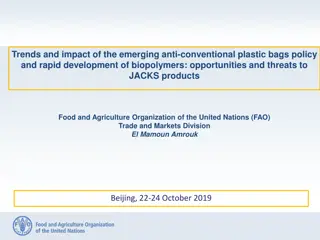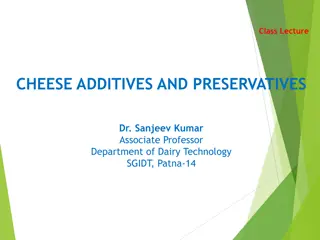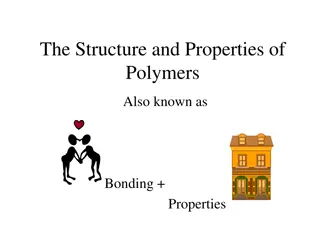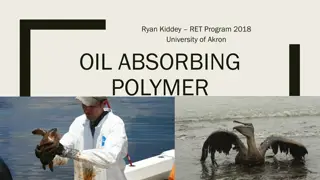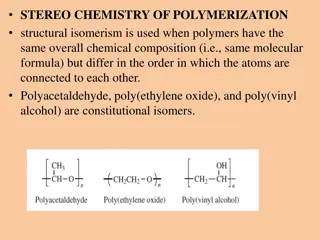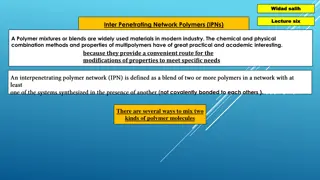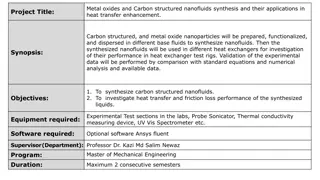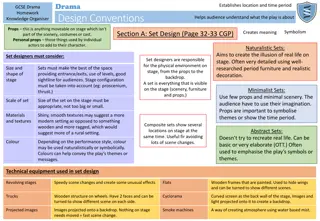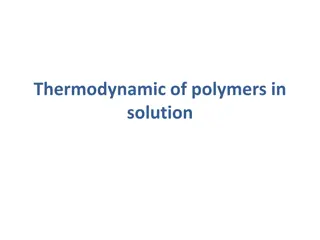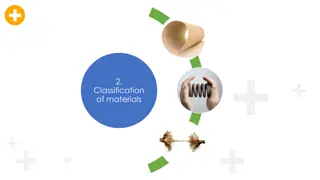Understanding Additives in Plastics and Polymers - GCSE Design Technology Lesson
Explore the world of plastics and polymers in this GCSE Design Technology lesson as you delve into the different additives used to enhance their properties. Gain insights into the origin of plastics, their environmental impact, and various additives like fillers, flame retardants, plasticizers, and stabilizers. Discover how these additives improve the functionality and aesthetics of plastics, with examples such as pigments for color change and plasticizers for increased flexibility. Engage in activities and discussions to deepen your understanding of material properties in plastics and polymers.
Download Presentation

Please find below an Image/Link to download the presentation.
The content on the website is provided AS IS for your information and personal use only. It may not be sold, licensed, or shared on other websites without obtaining consent from the author. Download presentation by click this link. If you encounter any issues during the download, it is possible that the publisher has removed the file from their server.
E N D
Presentation Transcript
GCSE Design Technology LESSON 4 MATERIAL PROPERTIES Plastics & Polymers Todays learning objectives: Understand different additives which are applied to polymers and how they improve them. - Develop knowledge and understanding of where plastics originate from and the significance to the environment. - Apply knowledge to a past paper exam question. -
GCSE Design Technology Plastics & Polymers MATERIAL PROPERTIES LESSON 4 Do Now activity Memory Test There are plenty of environmental issues with Plastics. Quickly create a mind map of what you remember for previous lessons to highlight the environmental issues.
GCSE Design Technology Plastics & Polymers MATERIAL PROPERTIES LESSON 4 Do Now activity Memory Test (Class review) There are plenty of environmental issues with Plastics. As a group lets share our mind map ideas to create a classroom view. PLASTICS & THE ENVIRONMENT
GCSE Design Technology Plastics & Polymers MATERIAL PROPERTIES LESSON 4 Additives added to polymers ADDITIVES - Are added to plastics to alter and improve their properties. FILLERS - Reduce the bulk of the plastic (makes them cheaper, or can increase strength or hardness) FLAME RETARDANT - Reduces the risk of combustion, creating a chemical reaction which can stop combustion. ANTI-STATIC - Reduces the effects of static charge that can build up through use. PLASTICISER - Reduces the softening temperature and makes them flow easier. STABILISER - Reduces the effect of UV light, stops the plastic degrading in sunlight Lets learn more about these.
Plastics & Polymers - Additives added to polymers ADDITIVES FILLERS FLAME RETARDANT. ANTI-STATIC PLASTICISER STABILISER
GCSE Design Technology MATERIAL PROPERTIES LESSON 4 Plastics & Polymers ADDITIVES - Are added to plastics to alter and improve their properties. The
GCSE Design Technology MATERIAL PROPERTIES ADDITIVES Many different chemicals and compounds can be added to enhance the functional and aesthetic properties of plastics. LESSON 4 Plastics & Polymers PIGMENTS are added to change the colour, PLASTICISERS are added to increase flexibility and FRAGRANCES can be added, as seen in some children s toys and air freshening products. Image result for plasticisers
GCSE Design Technology MATERIAL PROPERTIES LESSON 4 Plastics & Polymers The FILLERS - Reduce the bulk of the plastic (makes them cheaper, or can increase strength or hardness.)
GCSE Design Technology MATERIAL PROPERTIES LESSON 4 Plastics & Polymers Fillers - Are added to polymers to increase the stiffness and hardness of the material. The types of fillers applied to polymers are usually calcium carbonate (chalk), talc and barium sulphate. When adding the fillers the shape and size of the particles are important as the smaller these are increases the tensile strength and hardness. The purpose of using fillers is to improve the strength and heat resistance of a polymer.
GCSE Design Technology MATERIAL PROPERTIES LESSON 4 Plastics & Polymers FLAME RETARDANT - Reduces the risk of combustion, creating a chemical reaction which can stop combustion. The
GCSE Design Technology MATERIAL PROPERTIES LESSON 4 Plastics & Polymers FLAME RETARDANT - Most thermoplastic materials are flammable and will burn readily given sufficient heat energy. Fires from plastics can be devastating. Flame retardant additives can be added to a polymer to improve its fire resistance properties by increasing the materials ignition temperature, reducing flame circulation speeds and reducing smoke emissions. Flame retardant materials are obligatory in a vast range of applications, from building and construction products, household and electrical appliances. Image result for clip art video camera https://www.youtube.com/watch?v=HKl6dlBRQXk
GCSE Design Technology MATERIAL PROPERTIES LESSON 4 Plastics & Polymers The ANTI-STATIC - Reduces the effects of static charge that can build up through use.
GCSE Design Technology MATERIAL PROPERTIES LESSON 4 Plastics & Polymers Anti-static additives reduce static build up in polymers. They have the positive impact of reducing handling problems during transport and storage, then also dust build up on the finished part. Most polymer materials are good insulators and have the ability to support high static charge build up. This can be a particular problem for films which have large surface area to volume ratios. Static charge is produced by charge separation caused by the movement of one material over another. Static build up can result in issues including: Increased handling problems during transport, storage and packaging Dust attraction affecting both appearance and performance of plastic products Risk of electrical shock to employees working with the plastics and consumers that use them
GCSE Design Technology MATERIAL PROPERTIES LESSON 4 Plastics & Polymers The PLASTICISER - Reduces the softening temperature and makes them flow easier.
GCSE Design Technology MATERIAL PROPERTIES LESSON 4 Plastics & Polymers Plasticisers are small molecules that can be added to polymers during their manufacture. They push the polymer molecules slightly further apart, weakening the forces between them and making the material softer and more flexible. PVC & rubber are examples of polymers which use plasticisers. Without the invention of plasticisers most polymers would be too brittle and rigid. Many items we use every day include plasticisers from rubber soles on shoes to a flexible comb for brushing your hair. Virtually any polymer item you can think of has a plasticizer added to it, and often more than one to enhance its usability. PLASTICISER POLYMER CHAIN
GCSE Design Technology MATERIAL PROPERTIES LESSON 4 Plastics & Polymers The STABILISERS APPLIED TO POLYMERS - Reduces the effect of UV light, stops the plastic degrading in sunlight.
GCSE Design Technology MATERIAL PROPERTIES LESSON 4 Plastics & Polymers Plastics materials can be susceptible to damage by the action of UV radiation. Sunlight is a powerful source of UV radiation and products such as garden furniture, heating oil tanks, and greenhouse films which are required to spend extended periods outdoors as part of their service life will need protecting against this harmful degradation. UV Light will weaken certain plastics and produce a chalky faded appearance on the exposed surface. This photograph example shows a plastic garden chair which has faded due to sun light.
GCSE Design Technology MATERIAL PROPERTIES LESSON 4 Plastics & Polymers COMBATING PLASTIC FADING. The use of UV stabiliser systems allows parts for prolonged outdoor use, and in different climates with differing levels of UV light exposure, to be designed with a high level of confidence that they adequately fulfil their service life and performance requirements. Another feature of UV radiation is that it is not only potentially damaging to the polymer but also in packaging applications, to the contents of the packaging. UV radiation not only come from the sun, but can also come from artificial sources, like fluorescent lighting in supermarkets. Applications such as the above product will protect acrylic based products from UV damage. This could potentially cause undesirable changes to packaged goods e.g. colour change, and odour and flavour loss in foodstuffs. Adding a UV absorber will help protect the pack contents from damage by UV light.
GCSE Design Technology Plastics & Polymers MATERIAL PROPERTIES LESSON 4 Plenary Exam Q You have 12 minutes to answer. Including reading, highlighting & planning the Q.
GCSE Design Technology Plastics & Polymers MATERIAL PROPERTIES LESSON 4 Plenary Exam Q
GCSE Design Technology Plastics & Polymers MATERIAL PROPERTIES LESSON 4 Plenary Exam Q


